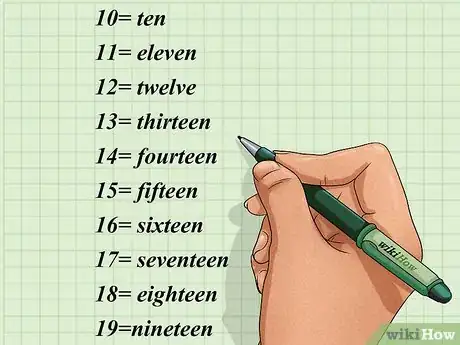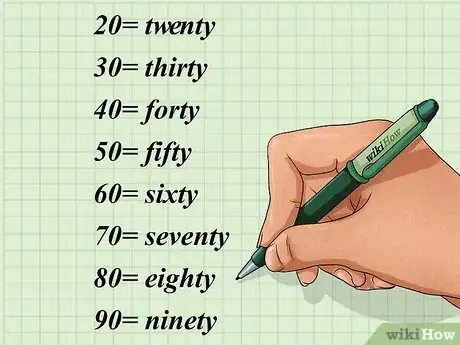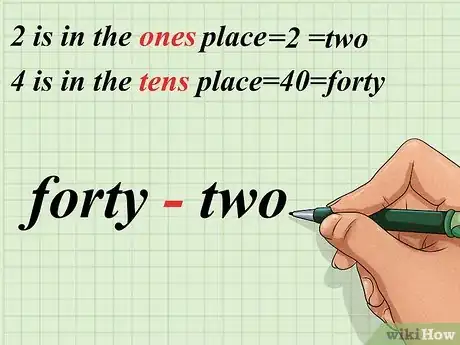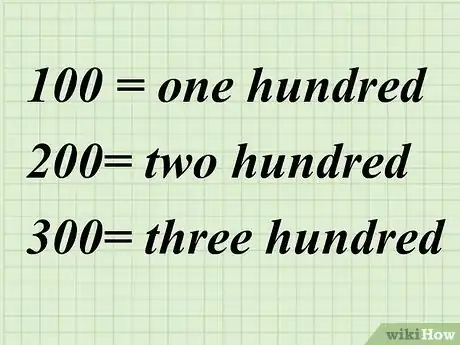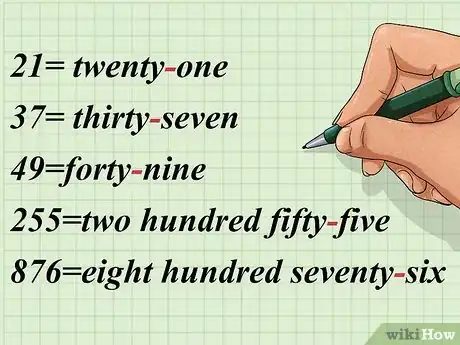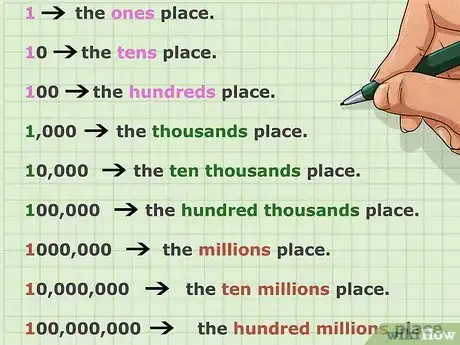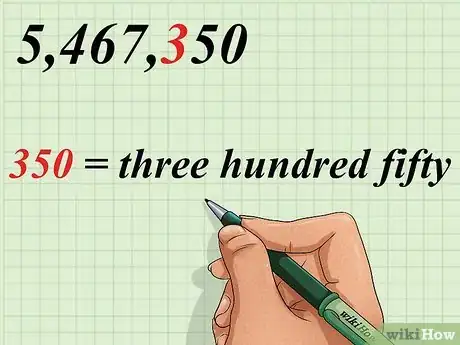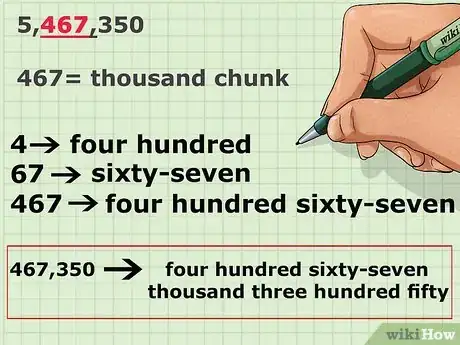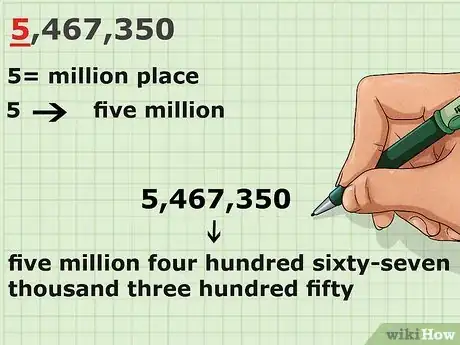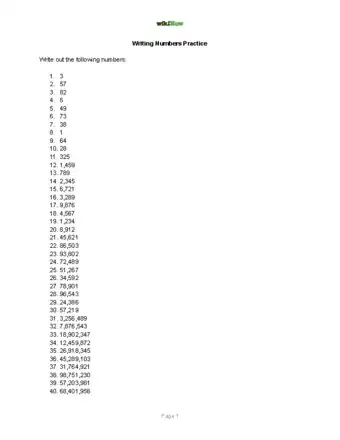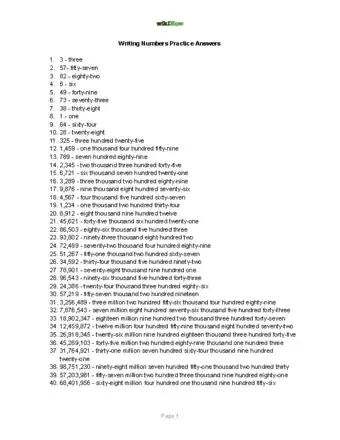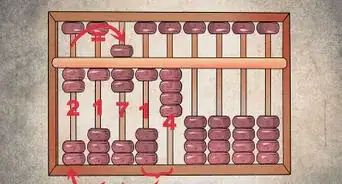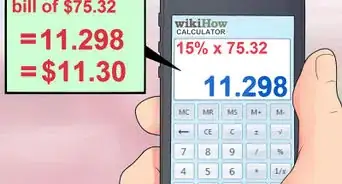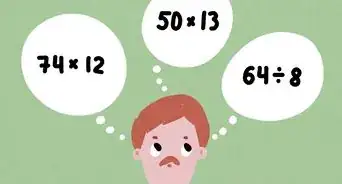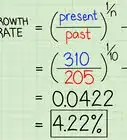wikiHow is a “wiki,” similar to Wikipedia, which means that many of our articles are co-written by multiple authors. To create this article, 21 people, some anonymous, worked to edit and improve it over time.
This article has been viewed 816,348 times.
Learn more...
Using words to write short numbers makes your writing look clean and classy. In handwriting, words are easy to read and hard to mistake for each other. While you may not need to write longer numbers as words that much, it's still helpful practice. This wikiHow will explain how you can write numbers as words.
Steps
Writing 1 to 999
-
1Learn to write numbers from 1 to 9. This is where it all starts. Learn these, and the rest gets much easier:
- 1 = one
- 2 = two
- 3 = three
- 4 = four
- 5 = five
- 6 = six
- 7 = seven
- 8 = eight
- 9 = nine
-
2Write numbers from 10 to 19. Do you see how many of them look just like the numbers above, plus "teen" at the end? "Sixteen" (16) just means "six and ten" (6 + 10).
- 10 = ten
- 11 = eleven
- 12 = twelve
- 13 = thirteen
- 14 = fourteen
- 15 = fifteen
- 16 = sixteen
- 17 = seventeen
- 18 = eighteen
- 19 = nineteen
Advertisement -
3Count in tens from 20 to 90. Here's how to write 20, 30, 40, and so on all the way to 100. You can recognize these numbers because they end in "ty" except 100).
- 20 = twenty
- 30 = thirty
- 40 = forty
- 50 = fifty
- 60 = sixty
- 70 = seventy
- 80 = eighty
- 90 = ninety
-
4Combine words to write more numbers. Now you can write any number from 1 to 100. Let's see how it works for the number 42:
- 42 is written with two numbers: 4 2.
- 2 is in the ones place, so this just equals 2. Write this as two.
- 4 is in the tens place, so this is actually 40. Write this as forty.
- Write the two parts together: forty-two. Don't forget the - sign between them.
-
5Count by hundreds. This part's easy if you remember the basics. Just write the number as usual and add "hundred:"
- 100 = one hundred
- 200 = two hundred
- 300 = three hundred (and so on)
-
6Write any number from 100 to 999. Just write the hundreds place, then the rest of the number. You don't need to write "and" or anything else between them. Here are some examples:
- 120 = one hundred twenty
- 405 = four hundred five
- 556 = five hundred fifty-six
- 999 = nine hundred ninety-nine
-
7Test yourself. Try writing a few numbers as words. Work on these, then highlight the space after the = sign to see if you're right:
- 21 = twenty-one
- 37 = thirty-seven
- 49 = forty-nine
- 255 = two hundred fifty-five
- 876 = eight hundred seventy-six
Writing Long Numbers
-
1Understand place values. We can tell what each digit in a number means based on where it is. Here's what the first 9 place values are called:[1]
- 1 → the ones place.
- 10 → the tens place.
- 100 → the hundreds place.
- 1,000 → the thousands place.
- 10,000 → the ten thousands place.
- 100,000 → the hundred thousands place.
- 1000,000 → the millions place.
- 10,000,000 → the ten millions place.
- 100,000,000 → the hundred millions place.
-
2Add commas to long numbers. Start from the right side of the number, at the ones place. Count three digits to the left, then add a comma. Keep separating the number in groups of three.
- For example, turn 458735 into 458,735.
- Write 1510800 as 1,510,800.
- You can use a period instead if that's how people in your country write numbers.
-
3Write the last two digits. Look at the two digits at the end of the number. This part is just like writing a normal two-digit number.
- 5,467,350 looks hard, but don't worry. Start with just the 50 at the end. Write this as fifty.
-
4Write the hundreds place. The next digit is the hundreds place. This is an easy one. Just write the number in that place, then add the word "hundred." Write this in front of your number.
- In 5,467,350, the 3 is the hundreds place. Write this as 'three hundred.
- Now we have 'three hundred fifty.
-
5Look at the next chunk of three. You just wrote the hundreds, tens, and ones place. The next three numbers are the thousands "chunk." These are the hundred thousands, ten thousands, and one thousands. Write these the same way, then add the word "thousand."
- In 5,467,350, the 467 is the thousands chunk.
- Write the 4 as four hundred.
- Write the 67 as sixty-seven.
- Write the whole chunk as four hundred sixty-seven thousand.
- Now we have four hundred sixty-seven thousand, three hundred fifty.
-
6Do the same for the millions. The next chunk of three numbers are the millions. These are the hundred millions, ten millions, and one millions. This is just the same as before, but with millions at the end.
- In 5,467,350, we only have a 5 in the millions place.
- Write this as five million.
- Finish writing the number: five million, four hundred sixty-seven thousand, three hundred fifty.
Writing Numbers Practice and Answers
Community Q&A
-
QuestionAm I correct if I write 350 as three hundred and fifty.
 Community AnswerYes, that form is easily understood. However, as the above article explains, it can also be written as "three hundred fifty."
Community AnswerYes, that form is easily understood. However, as the above article explains, it can also be written as "three hundred fifty." -
QuestionHow do I write a number with a decimal in words?
 DonaganTop AnswererFor example, you might express 10.3 as "ten point three" or "ten and three-tenths."
DonaganTop AnswererFor example, you might express 10.3 as "ten point three" or "ten and three-tenths." -
QuestionHow do I write 1,105,000?
 DonaganTop AnswererOne-million, one-hundred-five thousand.
DonaganTop AnswererOne-million, one-hundred-five thousand.
References
About This Article
To write numbers in words, start by learning to write the numbers one through nine. Once you know those words, learn the words for the numbers ten through nineteen. Then, count in tens from twenty to ninety. From there, you can write any number from one to one hundred by combining the words you've learned! To count by hundreds, write the number as usual, add the word "hundred," then write the rest of the number. For tips on writing numbers in the thousands and higher, read on!

